SBB-CFF-FFS Re 460
| SBB-CFF-FFS Re 460 | |||||||||||||||||||||||||||
|---|---|---|---|---|---|---|---|---|---|---|---|---|---|---|---|---|---|---|---|---|---|---|---|---|---|---|---|
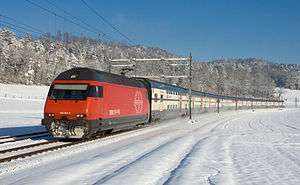 | |||||||||||||||||||||||||||
| |||||||||||||||||||||||||||
| |||||||||||||||||||||||||||
| |||||||||||||||||||||||||||
| |||||||||||||||||||||||||||
The Re 460 (popularly known as the Lok 2000) series are modern four-axle electric locomotives of the Swiss Federal Railways. Upon their entry into service in the early 1990s, they replaced the Ae 3/6I, Ae 4/7 and Re 4/4I series units, and displaced many of the Re 4/4II series into lesser duties.
The series was introduced as part of the Rail 2000 project, a massive project to modernise and improve capacity on Switzerland's railways.[4] While originally designed as a multipurpose locomotive, they are now used for passenger services only, often in conjunction with the IC 2000 double decker trains (often used to pull InterCity and InterRegio trains in German and French language areas). Their freight role has been assumed by Re 482s. They are maintained at Yverdon.
Assignment
When SBB was split up on 1 September 1999, Re 460 079–118 were assigned to the freight division, later becoming SBB Cargo. It was seen as an advantage to use all Re 460, which had been designed for 200 km/h, for passenger service. The passenger division passed the Re 6/6 to SBB Cargo and bought 079–095 on 1 January 2003, 096–102 2004 and the rest 2005.
Advertising
Due in part to their large, mainly flat bodysides, Swiss Federal Railways were approached early on with requests for the Re 460 to be used as mobile advertising hoardings. Despite opposition from some quarters, the money that could be earned swayed the decision and the first such locomotive, Re 460 015 was unveiled in 1994 in Agfa livery. Today no other loco type in Switzerland carries so many different liveries.
Naming
Almost all Re 460 locomotives are named, with the names being applied below the cab window at one end.
List of names:
|
|
Accidents and incidents
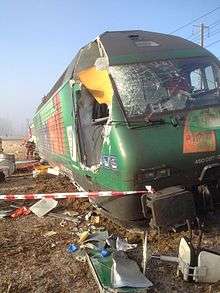
On 20 February 2015, locomotive No. 460 087-0 was involved in a collision with S-Bahn Class 514 electric multiple unit 514 146-2 at Rafz.
BLS
Swiss company BLS operates 18 similar locomotives, designated Re 465. These locomotives have efficiency modifications and individual axle control rather than individual bogie control which allows for slightly higher starting tractive effort, but are otherwise identical to the Re 460. Numbered 001-018, all are named.[5] These locomotives are used for both passenger and freight duties by BLS.[6]
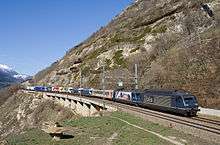
List of names:
- 001 Simplon/Sempione/Adler/Staatswappen Schweiz/Italien/BLS AplTransit/Lötschberg
- 002 Gornergrat
- 003 Jungfraujoch–Seespiele
- 004 Mittelallalin-Valaistourisme
- 005 Niesen
- 006 Lauchernalp
- 007 Schilthorn
- 008 Niederhorn
- 009 Napf
- 010 Mont Vully
- 011 Wisenberg
- 012 Euro Tunnel
- 013 Stockhorn
- 014 Spalenberg
- 015 Vue-des-Alpes
- 016 Centovalli
- 017 Schrattenflue
- 018 Brienz Rothorn Bahn
Usage abroad
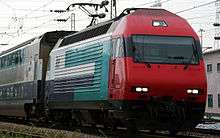
The MTR also operates two Lok2000 variants for its cross-boundary service from Hong Kong to Guangzhou. They were introduced in 1998 when the service was operated by the KCR; accordingly, the train is called the KTT, which stands for "KCR Through Train". These long-distance trains have ten double-deck carriages[7] and are equipped with knuckle couplers, instead of buffers and chain couplers. While the train has two locomotives, it is not operated in push-pull mode.
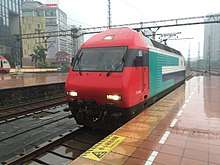
The 46 Sr2 locomotives of VR (Finnish Railways) are closely based on the Re 460, as are the 22 NSB El 18 class used by Norges Statsbaner of Norway. Indian Railways WAP-5 electric locomotives are also based on the Re 460.
See also
References
| Wikimedia Commons has media related to SBB Re 460. |
- ↑ The allowed top speed is 200 km/h. In order to get the approval to run at that speed, the locomotive must be able to go 15% faster; thus, the technical top speed is 230 km/h (140 mph), see Article by Bruno Lämmli Archived 2011-07-06 at the Wayback Machine. (German). However, this is not relevant in normal operation. Therefore, the table holds the allowed top speed, as for any other rail vehicle.
- ↑ http://documents.epfl.ch/users/a/al/allenbac/www/documents/Fich0312.pdf
- ↑ http://documents.epfl.ch/users/a/al/allenbac/www/documents/Fich0365.pdf
- ↑ "Bahn 2000 Rail Network Improvements, Switzerland". rail-technology.com. Retrieved 28 September 2009.
- ↑ "BLS Rolling Stock - Re 465". BLS AG. Retrieved 28 September 2009.
- ↑ "Class Re 465 locomotives for heavy-haul freight service". Professional Engineering Publishing. Retrieved 28 September 2009.
- ↑ "Kowloon-Canton Railway, China". rail-technology.com. Retrieved 28 September 2009.
This article was mostly translated from the German language version of December 2006.
